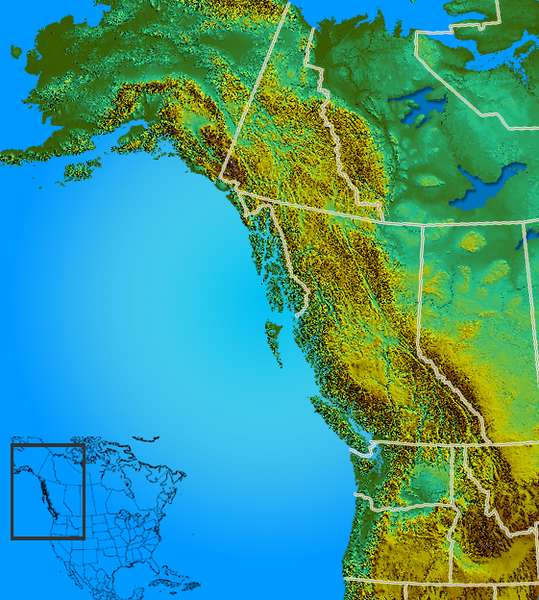Habitat and Geography by S u n i t a N a n d i h a l l i
H. haydeniana
is found to live in the Pacific Northwest region of the United
States. This includes Oregon, Washington, northern California,
and Vancouver Island. The type locality (or the area where this
species was first identified) of H. haydeniana was
Oregon, U.S.A. (Chamberlin & Hoffman 1958).

Figure 1. Organisms like H. haydeniana are found in the Pacific Northwest
region of North America.
Since
millipedes feed on dead plant material and fragments of organic
matter (Hopkin & Reed 1992) litter layer in mature conifer
forests with Douglas-fir is H. haydeniana’s habitat of
choice. (Acorn & Sheldon 2001). Adults are found in the
upper layer, immature stages deeper in the litter. However, the
leaf litter in the Pacific Northwest consists of a lot more than
just pine trees. Ash, Sycamore, Aspen, Birch, Cedar, Cherry,
Chestnut, Cypress, Dogwood, Fir, Elm, Oak, Maple, Spruce, and
Redwood are just a few more common trees that grow in this area
and that H. haydeniana has fed on as well. (Jensen et
al. 2011).
It has been
shown in numerous cases that millipedes are better for plant
growth and, in turn, ecosystems altogether, than even worms.
This is because H. haydeniana excretes decomposed organic
matter in the form of fecal pellets. (Thakur et al. 2011).
It was found that higher
values of Nitrogen, Phosphorous, Potassium, Magnesium, and
Calcium (necessary nutrients in order for plants to produce
enzymes and nucleic acids) were observed in millipede compost as
opposed to worm compost or ordinary soil. Since millipede feces
are so high in nutrients, it is not uncommon for them to partake
in coprophagy or the eating of one’s own feces in order to gain
extra nutrients that you previously didn’t during the first full
cycle of digestion.
Although the
chemical defenses of H. haydeniana are able to keep most
predators at bay, one specific beetle is specialized in
consuming H. haydeniana. P. laevissimus also lives
in California, Oregon, and Washington and feeds on millipedes
like H. haydeniana. (Denton 1997).

Figure 2.
References in Order of Appearance:
Chamberlin, R.V. and Hoffman, R.L. 1958. Checklist of the millipedes of North America. United States Government Printing Office, Washington, D.C., U.S.A.
Hopkin, S.P. and Read, H.J. 1992. The biology of millipedes. Oxford University Press, New York, U.S.A.
Acorn, J. and Sheldon, I. 2001. Bugs of Washington and Oregon. Lone Pine Publishing, Edmonton, Canada.
Jensen, E., Zahler, D., Patterson, B., & Littlefield, B. 2011. Common trees of the pacific northwest. Oregon State University. <URL: http://oregonstate.edu/trees/name_common.html> Accessed 9 November 2013.
Thakur, P.C., Apurva, P., and Sinha, S.K. 2011. Comparative study of characteristics of biocompost produced by millipedes and earthworms. Advances in Applied Science Research 2: 94-98.
Denton, M. 1997. Promecognathus
laevissimus dejean 1829. The Evergreen State College. <URL:
http://academic.evergreen.edu/projects/evergreenBiota/kingdom/animalia/phylum/arthropoda/class/insecta/order/coleoptera/family/carabidae/
GENERA/PROMECOGNATHUS/P_laevissimus.HTM > Accessed 9 November
2013.
Wikimedia Commons 2012.
<http://commons.wikimedia.org/wiki/File:Pacific_northwest-relief.png>
Accessed 19 November 2013.